BMP6003 - International HRM: 3 Key HR Practices for H&M Global
VerifiedAdded on 2023/06/18
|15
|1553
|86
Presentation
AI Summary
This presentation provides an overview of three crucial Human Resource Management (HRM) practices for international businesses, focusing on H&M as a case study. It examines recruitment and selection strategies, highlighting the importance of attracting and selecting suitable candidates while acknowledging the time and cost involved. The presentation also discusses managing diversity in teams and groups, emphasizing the benefits of diverse perspectives but also addressing potential integration and performance challenges. Furthermore, it explores reward management, noting its role in motivating employees through fair compensation and benefits, while also considering potential drawbacks such as jealousy and demotivation. The presentation concludes by addressing the challenges H&M faces in implementing these HR practices, including maintaining balanced employee relationships, enabling motivation, and ensuring employee awareness. The report emphasizes the significant role of HR policies in international business operations.
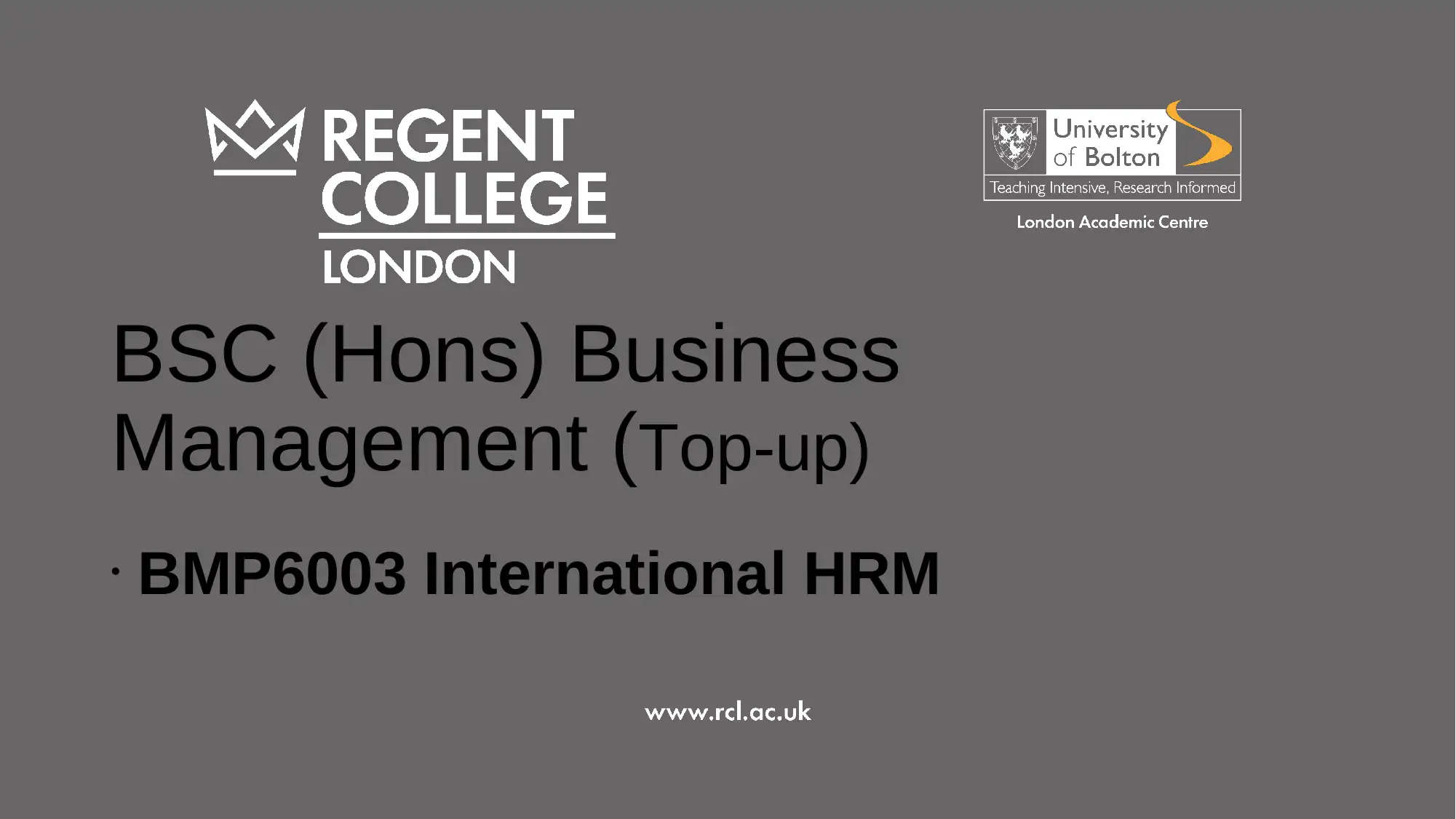
BSC (Hons) Business
Management (Top-up)
• BMP6003 International HRM
Management (Top-up)
• BMP6003 International HRM
Paraphrase This Document
Need a fresh take? Get an instant paraphrase of this document with our AI Paraphraser
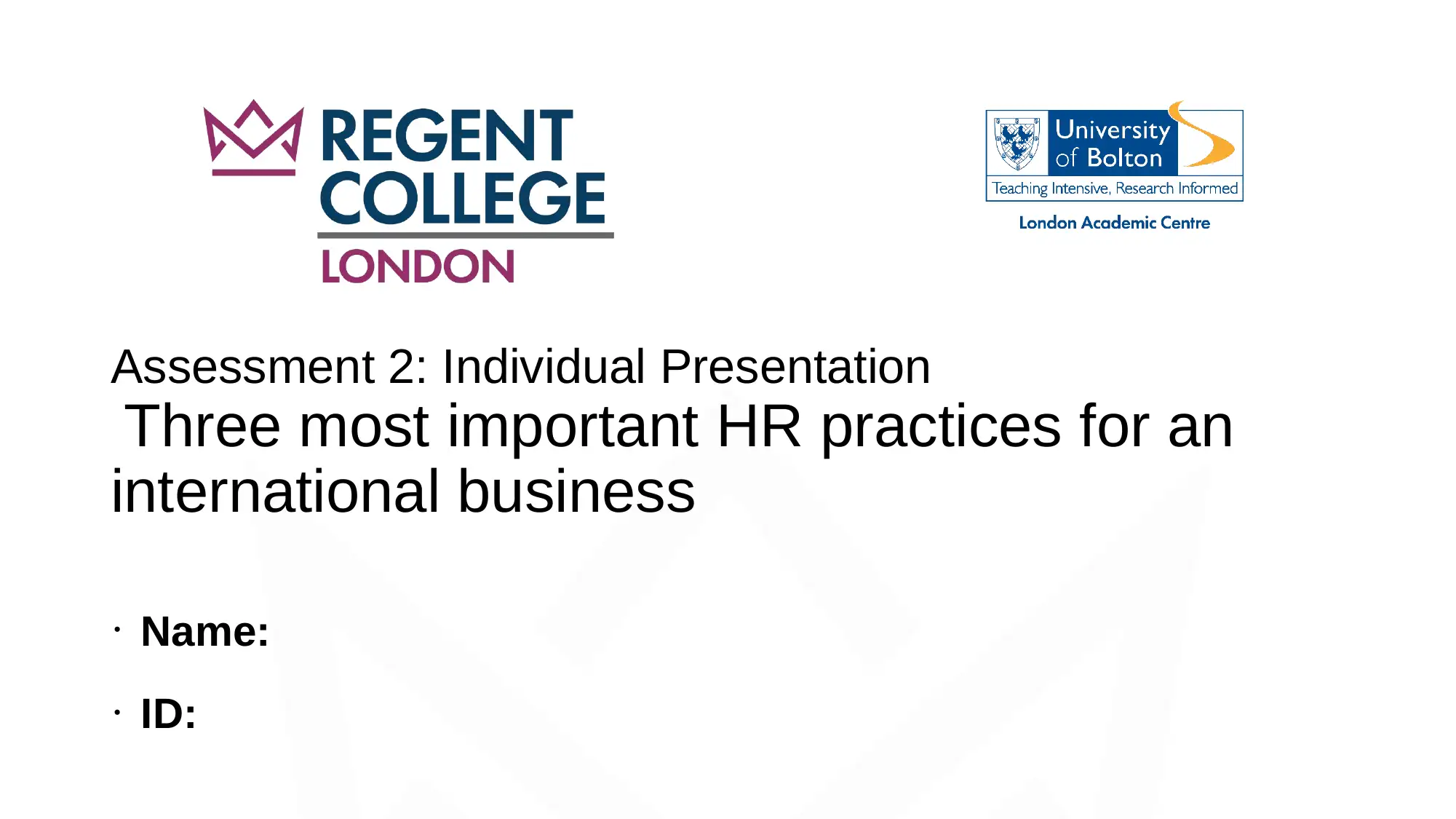
Assessment 2: Individual Presentation
Three most important HR practices for an
international business
• Name:
• ID:
Three most important HR practices for an
international business
• Name:
• ID:
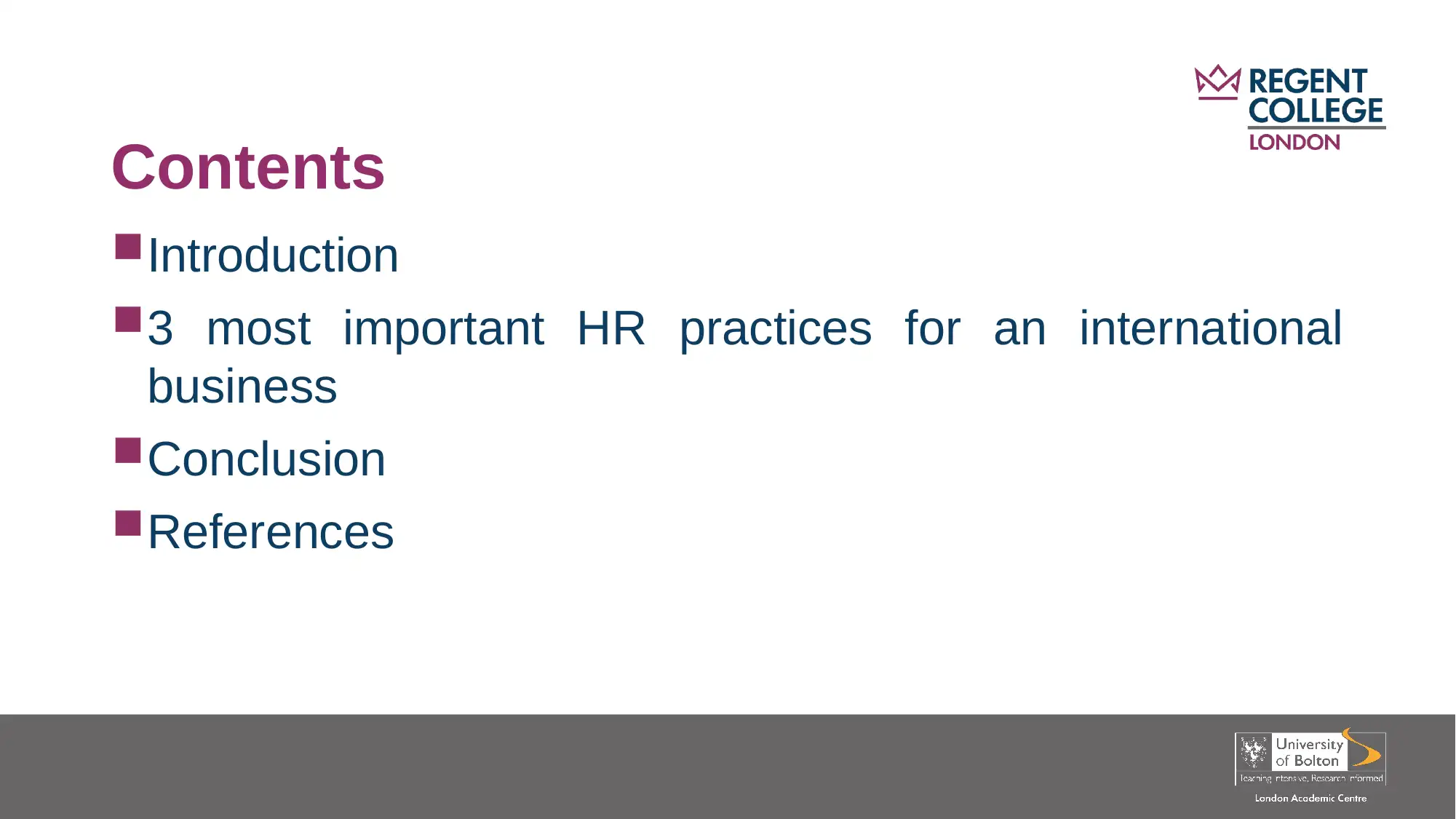
Contents
Introduction
3 most important HR practices for an international
business
Conclusion
References
Introduction
3 most important HR practices for an international
business
Conclusion
References
⊘ This is a preview!⊘
Do you want full access?
Subscribe today to unlock all pages.

Trusted by 1+ million students worldwide
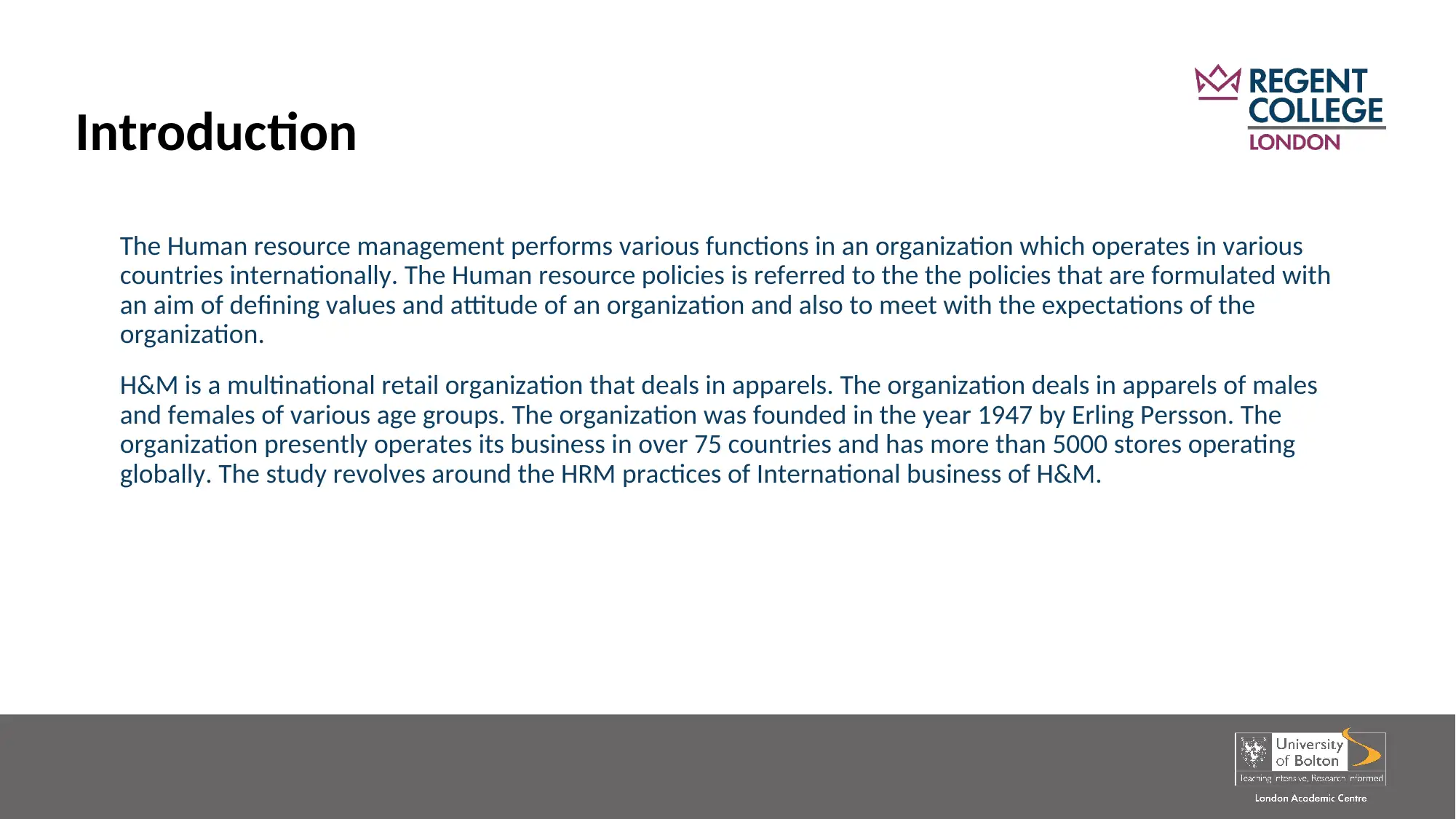
Introduction
The Human resource management performs various functions in an organization which operates in various
countries internationally. The Human resource policies is referred to the the policies that are formulated with
an aim of defining values and attitude of an organization and also to meet with the expectations of the
organization.
H&M is a multinational retail organization that deals in apparels. The organization deals in apparels of males
and females of various age groups. The organization was founded in the year 1947 by Erling Persson. The
organization presently operates its business in over 75 countries and has more than 5000 stores operating
globally. The study revolves around the HRM practices of International business of H&M.
The Human resource management performs various functions in an organization which operates in various
countries internationally. The Human resource policies is referred to the the policies that are formulated with
an aim of defining values and attitude of an organization and also to meet with the expectations of the
organization.
H&M is a multinational retail organization that deals in apparels. The organization deals in apparels of males
and females of various age groups. The organization was founded in the year 1947 by Erling Persson. The
organization presently operates its business in over 75 countries and has more than 5000 stores operating
globally. The study revolves around the HRM practices of International business of H&M.
Paraphrase This Document
Need a fresh take? Get an instant paraphrase of this document with our AI Paraphraser
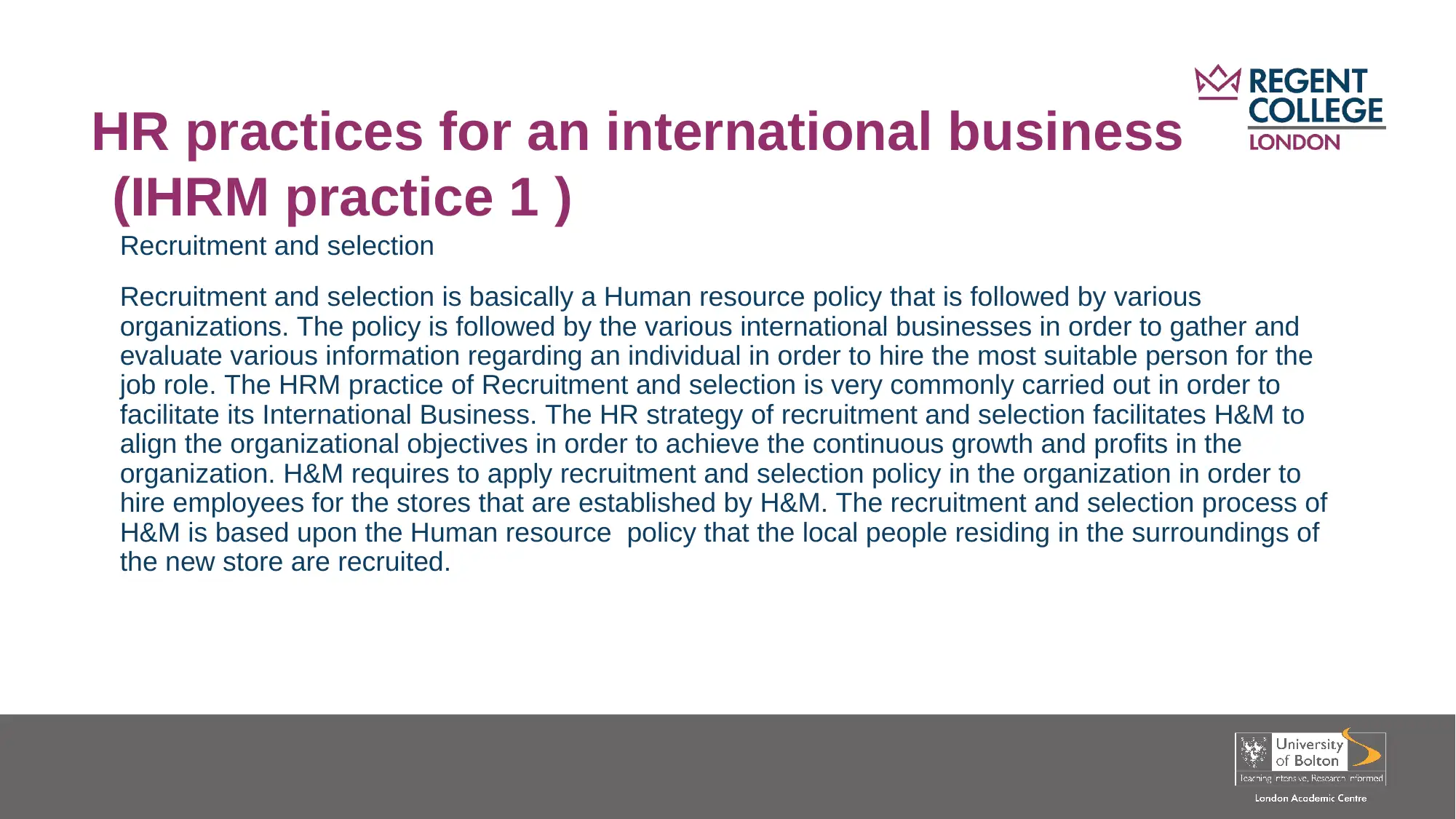
HR practices for an international business
(IHRM practice 1 )
Recruitment and selection
Recruitment and selection is basically a Human resource policy that is followed by various
organizations. The policy is followed by the various international businesses in order to gather and
evaluate various information regarding an individual in order to hire the most suitable person for the
job role. The HRM practice of Recruitment and selection is very commonly carried out in order to
facilitate its International Business. The HR strategy of recruitment and selection facilitates H&M to
align the organizational objectives in order to achieve the continuous growth and profits in the
organization. H&M requires to apply recruitment and selection policy in the organization in order to
hire employees for the stores that are established by H&M. The recruitment and selection process of
H&M is based upon the Human resource policy that the local people residing in the surroundings of
the new store are recruited.
(IHRM practice 1 )
Recruitment and selection
Recruitment and selection is basically a Human resource policy that is followed by various
organizations. The policy is followed by the various international businesses in order to gather and
evaluate various information regarding an individual in order to hire the most suitable person for the
job role. The HRM practice of Recruitment and selection is very commonly carried out in order to
facilitate its International Business. The HR strategy of recruitment and selection facilitates H&M to
align the organizational objectives in order to achieve the continuous growth and profits in the
organization. H&M requires to apply recruitment and selection policy in the organization in order to
hire employees for the stores that are established by H&M. The recruitment and selection process of
H&M is based upon the Human resource policy that the local people residing in the surroundings of
the new store are recruited.
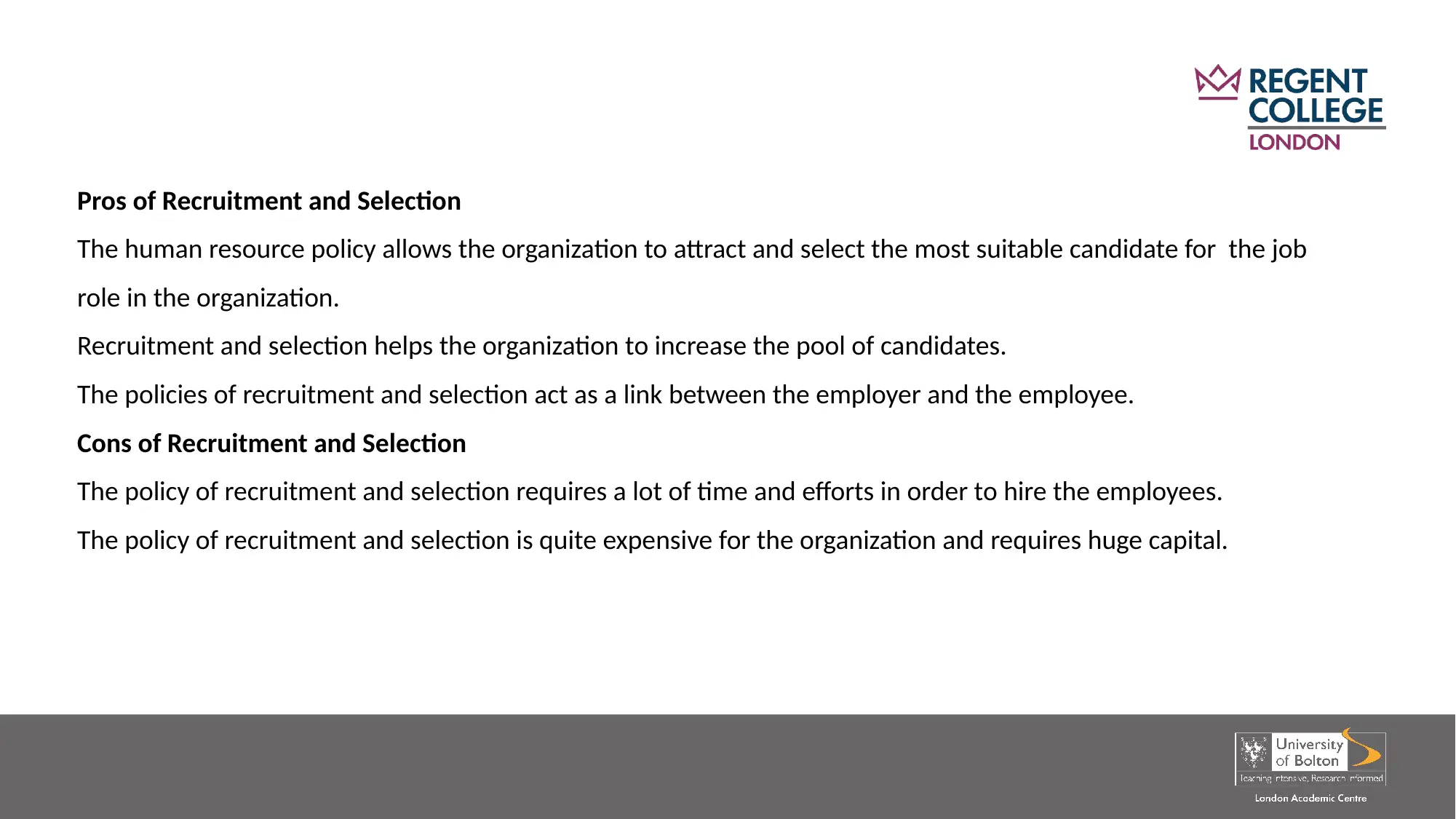
Pros of Recruitment and Selection
The human resource policy allows the organization to attract and select the most suitable candidate for the job
role in the organization.
Recruitment and selection helps the organization to increase the pool of candidates.
The policies of recruitment and selection act as a link between the employer and the employee.
Cons of Recruitment and Selection
The policy of recruitment and selection requires a lot of time and efforts in order to hire the employees.
The policy of recruitment and selection is quite expensive for the organization and requires huge capital.
The human resource policy allows the organization to attract and select the most suitable candidate for the job
role in the organization.
Recruitment and selection helps the organization to increase the pool of candidates.
The policies of recruitment and selection act as a link between the employer and the employee.
Cons of Recruitment and Selection
The policy of recruitment and selection requires a lot of time and efforts in order to hire the employees.
The policy of recruitment and selection is quite expensive for the organization and requires huge capital.
⊘ This is a preview!⊘
Do you want full access?
Subscribe today to unlock all pages.

Trusted by 1+ million students worldwide
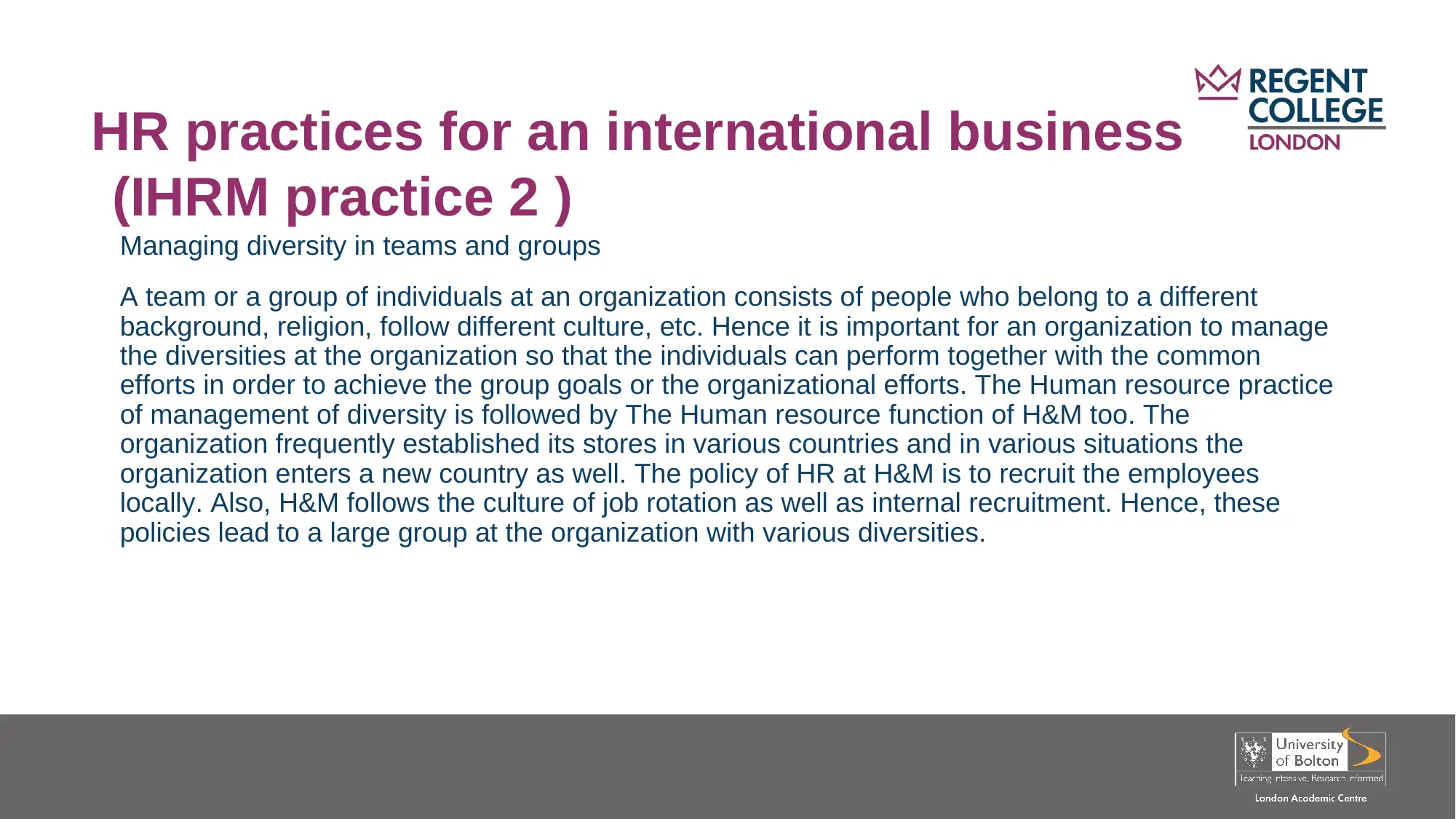
HR practices for an international business
(IHRM practice 2 )
Managing diversity in teams and groups
A team or a group of individuals at an organization consists of people who belong to a different
background, religion, follow different culture, etc. Hence it is important for an organization to manage
the diversities at the organization so that the individuals can perform together with the common
efforts in order to achieve the group goals or the organizational efforts. The Human resource practice
of management of diversity is followed by The Human resource function of H&M too. The
organization frequently established its stores in various countries and in various situations the
organization enters a new country as well. The policy of HR at H&M is to recruit the employees
locally. Also, H&M follows the culture of job rotation as well as internal recruitment. Hence, these
policies lead to a large group at the organization with various diversities.
(IHRM practice 2 )
Managing diversity in teams and groups
A team or a group of individuals at an organization consists of people who belong to a different
background, religion, follow different culture, etc. Hence it is important for an organization to manage
the diversities at the organization so that the individuals can perform together with the common
efforts in order to achieve the group goals or the organizational efforts. The Human resource practice
of management of diversity is followed by The Human resource function of H&M too. The
organization frequently established its stores in various countries and in various situations the
organization enters a new country as well. The policy of HR at H&M is to recruit the employees
locally. Also, H&M follows the culture of job rotation as well as internal recruitment. Hence, these
policies lead to a large group at the organization with various diversities.
Paraphrase This Document
Need a fresh take? Get an instant paraphrase of this document with our AI Paraphraser
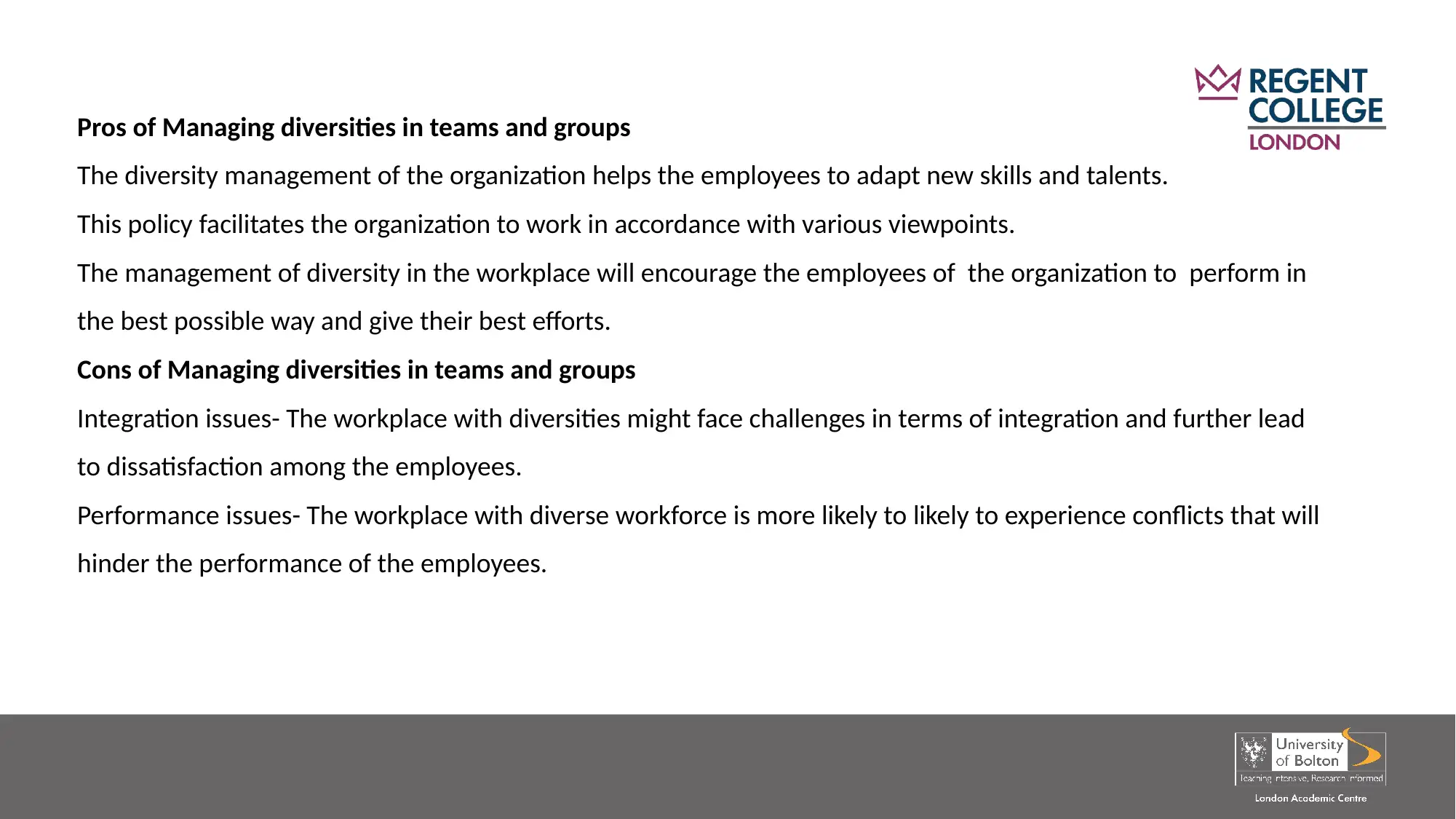
Pros of Managing diversities in teams and groups
The diversity management of the organization helps the employees to adapt new skills and talents.
This policy facilitates the organization to work in accordance with various viewpoints.
The management of diversity in the workplace will encourage the employees of the organization to perform in
the best possible way and give their best efforts.
Cons of Managing diversities in teams and groups
Integration issues- The workplace with diversities might face challenges in terms of integration and further lead
to dissatisfaction among the employees.
Performance issues- The workplace with diverse workforce is more likely to likely to experience conflicts that will
hinder the performance of the employees.
The diversity management of the organization helps the employees to adapt new skills and talents.
This policy facilitates the organization to work in accordance with various viewpoints.
The management of diversity in the workplace will encourage the employees of the organization to perform in
the best possible way and give their best efforts.
Cons of Managing diversities in teams and groups
Integration issues- The workplace with diversities might face challenges in terms of integration and further lead
to dissatisfaction among the employees.
Performance issues- The workplace with diverse workforce is more likely to likely to experience conflicts that will
hinder the performance of the employees.
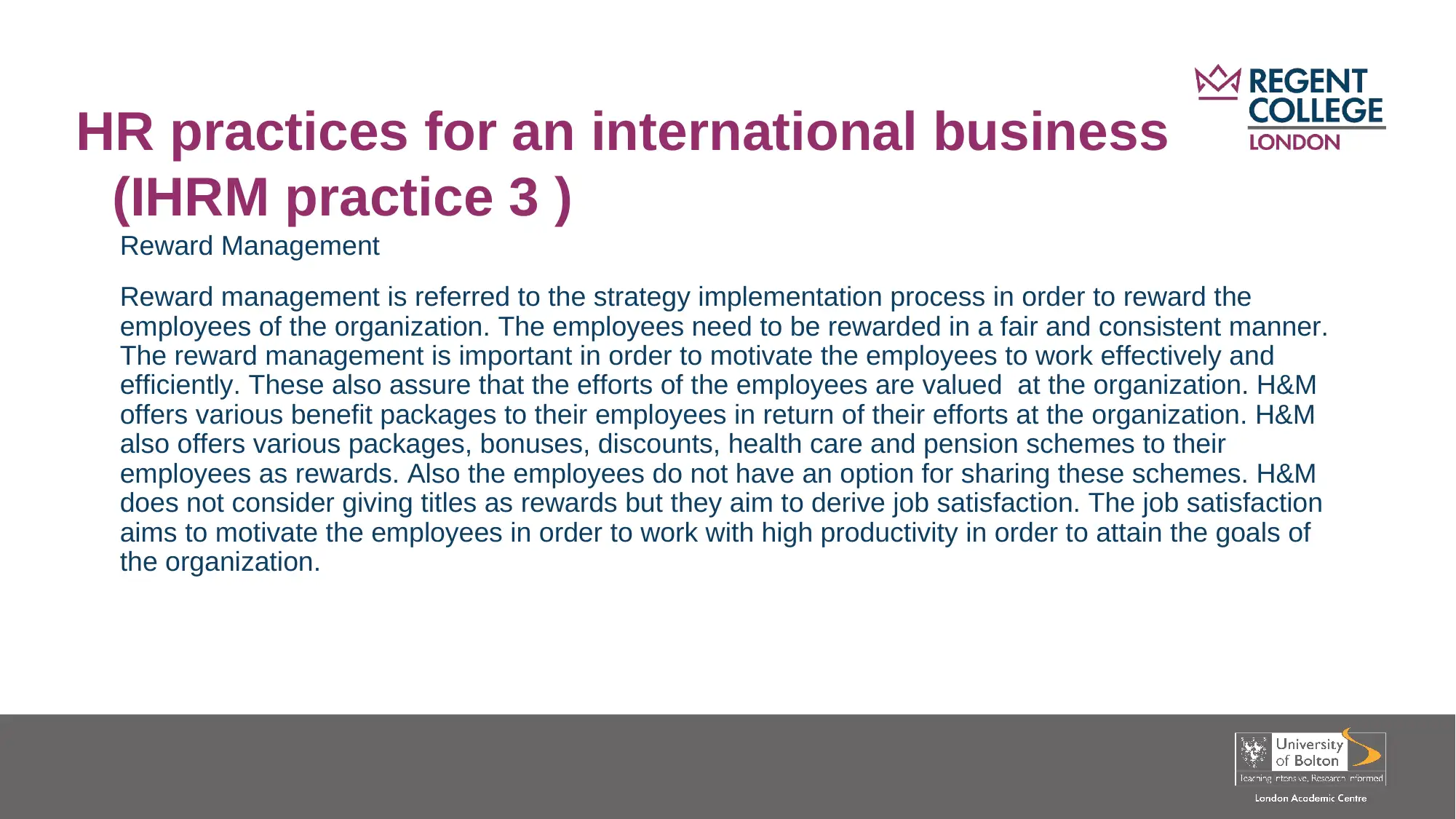
HR practices for an international business
(IHRM practice 3 )
Reward Management
Reward management is referred to the strategy implementation process in order to reward the
employees of the organization. The employees need to be rewarded in a fair and consistent manner.
The reward management is important in order to motivate the employees to work effectively and
efficiently. These also assure that the efforts of the employees are valued at the organization. H&M
offers various benefit packages to their employees in return of their efforts at the organization. H&M
also offers various packages, bonuses, discounts, health care and pension schemes to their
employees as rewards. Also the employees do not have an option for sharing these schemes. H&M
does not consider giving titles as rewards but they aim to derive job satisfaction. The job satisfaction
aims to motivate the employees in order to work with high productivity in order to attain the goals of
the organization.
(IHRM practice 3 )
Reward Management
Reward management is referred to the strategy implementation process in order to reward the
employees of the organization. The employees need to be rewarded in a fair and consistent manner.
The reward management is important in order to motivate the employees to work effectively and
efficiently. These also assure that the efforts of the employees are valued at the organization. H&M
offers various benefit packages to their employees in return of their efforts at the organization. H&M
also offers various packages, bonuses, discounts, health care and pension schemes to their
employees as rewards. Also the employees do not have an option for sharing these schemes. H&M
does not consider giving titles as rewards but they aim to derive job satisfaction. The job satisfaction
aims to motivate the employees in order to work with high productivity in order to attain the goals of
the organization.
⊘ This is a preview!⊘
Do you want full access?
Subscribe today to unlock all pages.

Trusted by 1+ million students worldwide
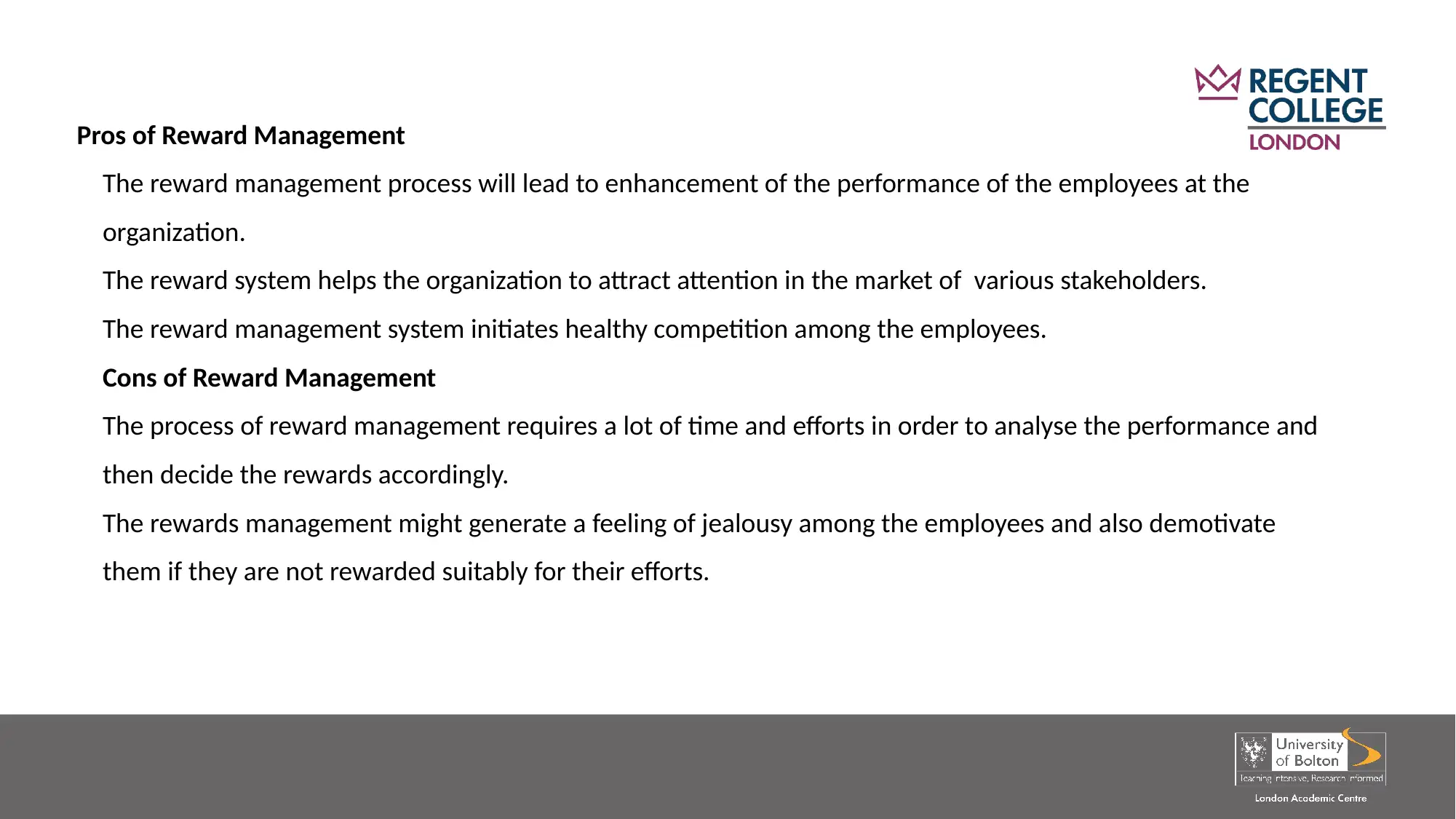
Pros of Reward Management
The reward management process will lead to enhancement of the performance of the employees at the
organization.
The reward system helps the organization to attract attention in the market of various stakeholders.
The reward management system initiates healthy competition among the employees.
Cons of Reward Management
The process of reward management requires a lot of time and efforts in order to analyse the performance and
then decide the rewards accordingly.
The rewards management might generate a feeling of jealousy among the employees and also demotivate
them if they are not rewarded suitably for their efforts.
The reward management process will lead to enhancement of the performance of the employees at the
organization.
The reward system helps the organization to attract attention in the market of various stakeholders.
The reward management system initiates healthy competition among the employees.
Cons of Reward Management
The process of reward management requires a lot of time and efforts in order to analyse the performance and
then decide the rewards accordingly.
The rewards management might generate a feeling of jealousy among the employees and also demotivate
them if they are not rewarded suitably for their efforts.
Paraphrase This Document
Need a fresh take? Get an instant paraphrase of this document with our AI Paraphraser
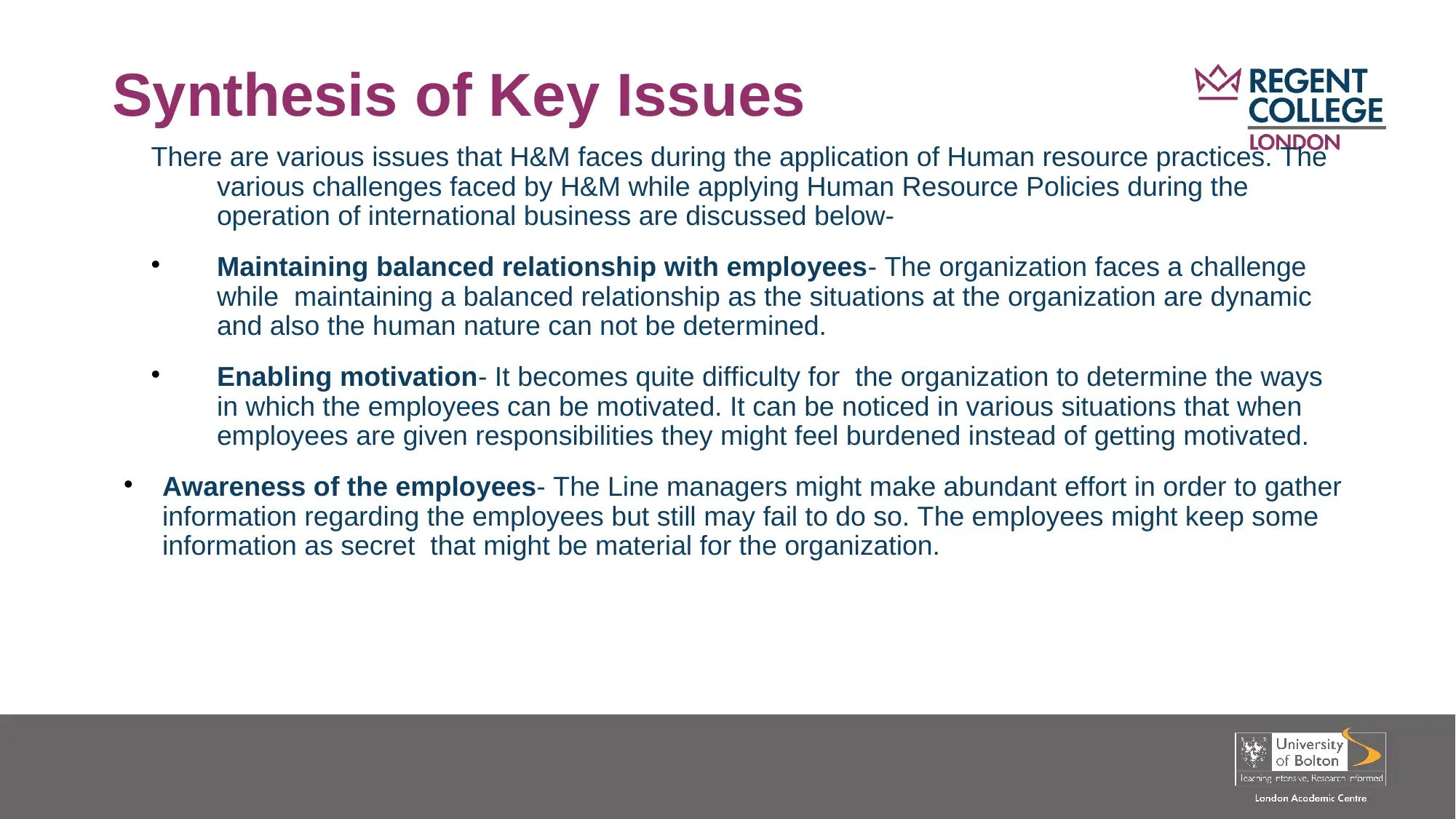
Synthesis of Key Issues
There are various issues that H&M faces during the application of Human resource practices. The
various challenges faced by H&M while applying Human Resource Policies during the
operation of international business are discussed below-
Maintaining balanced relationship with employees- The organization faces a challenge
while maintaining a balanced relationship as the situations at the organization are dynamic
and also the human nature can not be determined.
Enabling motivation- It becomes quite difficulty for the organization to determine the ways
in which the employees can be motivated. It can be noticed in various situations that when
employees are given responsibilities they might feel burdened instead of getting motivated.
Awareness of the employees- The Line managers might make abundant effort in order to gather
information regarding the employees but still may fail to do so. The employees might keep some
information as secret that might be material for the organization.
There are various issues that H&M faces during the application of Human resource practices. The
various challenges faced by H&M while applying Human Resource Policies during the
operation of international business are discussed below-
Maintaining balanced relationship with employees- The organization faces a challenge
while maintaining a balanced relationship as the situations at the organization are dynamic
and also the human nature can not be determined.
Enabling motivation- It becomes quite difficulty for the organization to determine the ways
in which the employees can be motivated. It can be noticed in various situations that when
employees are given responsibilities they might feel burdened instead of getting motivated.
Awareness of the employees- The Line managers might make abundant effort in order to gather
information regarding the employees but still may fail to do so. The employees might keep some
information as secret that might be material for the organization.
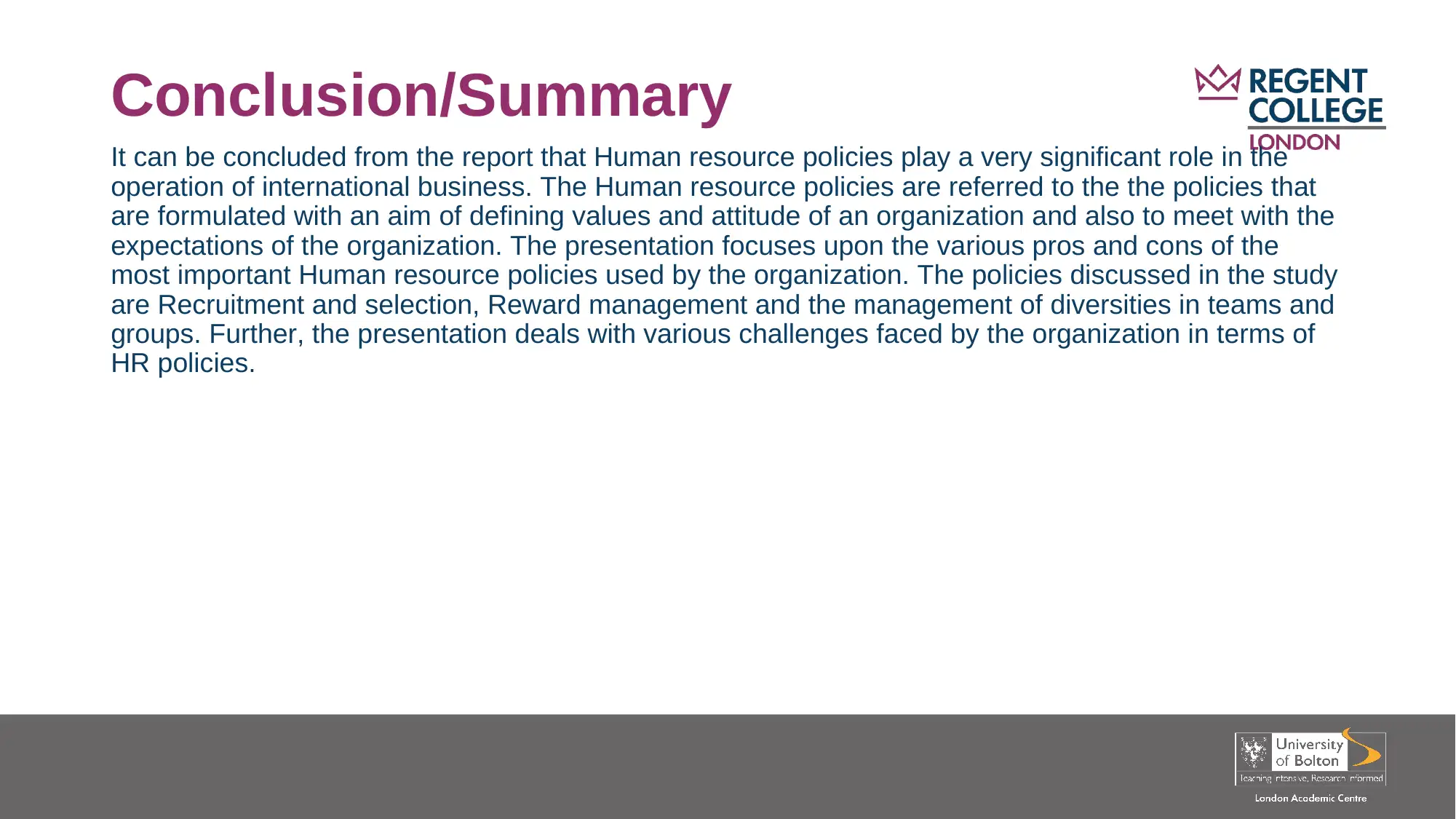
Conclusion/Summary
It can be concluded from the report that Human resource policies play a very significant role in the
operation of international business. The Human resource policies are referred to the the policies that
are formulated with an aim of defining values and attitude of an organization and also to meet with the
expectations of the organization. The presentation focuses upon the various pros and cons of the
most important Human resource policies used by the organization. The policies discussed in the study
are Recruitment and selection, Reward management and the management of diversities in teams and
groups. Further, the presentation deals with various challenges faced by the organization in terms of
HR policies.
It can be concluded from the report that Human resource policies play a very significant role in the
operation of international business. The Human resource policies are referred to the the policies that
are formulated with an aim of defining values and attitude of an organization and also to meet with the
expectations of the organization. The presentation focuses upon the various pros and cons of the
most important Human resource policies used by the organization. The policies discussed in the study
are Recruitment and selection, Reward management and the management of diversities in teams and
groups. Further, the presentation deals with various challenges faced by the organization in terms of
HR policies.
⊘ This is a preview!⊘
Do you want full access?
Subscribe today to unlock all pages.

Trusted by 1+ million students worldwide
1 out of 15
Related Documents
Your All-in-One AI-Powered Toolkit for Academic Success.
+13062052269
info@desklib.com
Available 24*7 on WhatsApp / Email
![[object Object]](/_next/static/media/star-bottom.7253800d.svg)
Unlock your academic potential
Copyright © 2020–2025 A2Z Services. All Rights Reserved. Developed and managed by ZUCOL.




